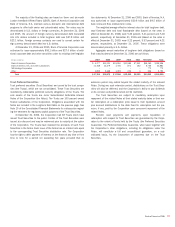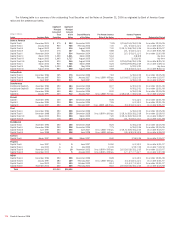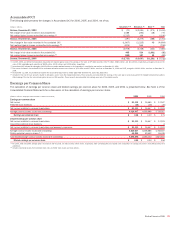Bank of America 2006 Annual Report Download - page 129
Download and view the complete annual report
Please find page 129 of the 2006 Bank of America annual report below. You can navigate through the pages in the report by either clicking on the pages listed below, or by using the keyword search tool below to find specific information within the annual report.
Note 13 – Commitments and Contingencies
In the normal course of business, the Corporation enters into a number of
off-balance sheet commitments. These commitments expose the Corpo-
ration to varying degrees of credit and market risk and are subject to the
same credit and market risk limitation reviews as those instruments
recorded on the Corporation’s Consolidated Balance Sheet.
Credit Extension Commitments
The Corporation enters into commitments to extend credit such as loan
commitments, SBLCs and commercial letters of credit to meet the financ-
ing needs of its customers. The outstanding unfunded lending commit-
ments shown in the following table have been reduced by amounts
participated to other financial institutions of $30.5 billion and $30.4 bil-
lion at December 31, 2006 and 2005. The carrying amount for these
commitments, which represents the liability recorded related to these
instruments, at December 31, 2006 and 2005 was $444 million and
$458 million. At December 31, 2006, the carrying amount included
deferred revenue of $47 million and a reserve for unfunded lending com-
mitments of $397 million. At December 31, 2005, the carrying amount
included deferred revenue of $63 million and a reserve for unfunded lend-
ing commitments of $395 million.
December 31
(Dollars in millions) 2006 2005
Loan commitments
(1)
$ 338,205
$271,906
Home equity lines of credit
98,200
78,626
Standby letters of credit and financial guarantees
53,006
48,129
Commercial letters of credit
4,482
5,972
Legally binding commitments
493,893
404,633
Credit card lines
(2)
853,592
192,967
Total
$1,347,485
$597,600
(1) Included at December 31, 2006 and 2005, were equity commitments of $2.8 billion and $1.5 billion,
related to obligations to further fund equity investments.
(2) As part of the MBNA merger on January 1, 2006, the Corporation acquired $588.4 billion of unused credit
card lines.
Legally binding commitments to extend credit generally have speci-
fied rates and maturities. Certain of these commitments have adverse
change clauses that help to protect the Corporation against deterioration
in the borrowers’ ability to pay.
The Corporation issues SBLCs and financial guarantees to support
the obligations of its customers to beneficiaries. Additionally, in many
cases, the Corporation holds collateral in various forms against these
SBLCs. As part of its risk management activities, the Corporation con-
tinuously monitors the creditworthiness of the customer as well as SBLC
exposure; however, if the customer fails to perform the specified obliga-
tion to the beneficiary, the beneficiary may draw upon the SBLC by present-
ing documents that are in compliance with the letter of credit terms. In
that event, the Corporation either repays the money borrowed or advanced,
makes payment on account of the indebtedness of the customer or makes
payment on account of the default by the customer in the performance of
an obligation to the beneficiary up to the full notional amount of the SBLC.
The customer is obligated to reimburse the Corporation for any such
payment. If the customer fails to pay, the Corporation would, as con-
tractually permitted, liquidate collateral and/or offset accounts.
Commercial letters of credit, issued primarily to facilitate customer
trade finance activities, are usually collateralized by the underlying goods
being shipped to the customer and are generally short-term. Credit card
lines are unsecured commitments that are not legally binding. Manage-
ment reviews credit card lines at least annually, and upon evaluation of
the customers’ creditworthiness, the Corporation has the right to termi-
nate or change certain terms of the credit card lines.
The Corporation uses various techniques to manage risk associated
with these types of instruments that include obtaining collateral and/or
adjusting commitment amounts based on the borrower’s financial con-
dition; therefore, the total commitment amount does not necessarily
represent the actual risk of loss or future cash requirements. For each of
these types of instruments, the Corporation’s maximum exposure to credit
loss is represented by the contractual amount of these instruments.
Other Commitments
At December 31, 2006 and 2005, charge cards (nonrevolving card lines)
to individuals and government entities guaranteed by the U.S. government
in the amount of $9.6 billion and $9.4 billion were not included in credit
card line commitments in the previous table. The outstanding balances
related to these charge cards were $193 million and $171 million at
December 31, 2006 and 2005.
At December 31, 2006, the Corporation had whole mortgage loan
purchase commitments of $8.5 billion, all of which will settle in the first
quarter of 2007. At December 31, 2005, the Corporation had whole mort-
gage loan purchase commitments of $4.0 billion, all of which settled in
the first quarter of 2006.
The Corporation has entered into operating leases for certain of its
premises and equipment. Commitments under these leases approximate
$1.4 billion in 2007, $1.3 billion in 2008, $1.1 billion in 2009, $931 mil-
lion in 2010, $801 million in 2011, and $6.0 billion for all years there-
after.
In 2005, the Corporation entered into an agreement for the commit-
ted purchase of retail automotive loans over a five-year period ending
June 30, 2010. In 2005, the Corporation purchased $5.0 billion of such
loans. In 2006, the Corporation purchased $7.5 billion of such loans.
Under the agreement, the Corporation is committed to purchase up to
$5.0 billion of such loans for the period July 1, 2006 through June 30,
2007 and up to $10.0 billion in each of the agreement’s next three fiscal
years. As of December 31, 2006, the remaining commitment amount was
$32.5 billion.
Other Guarantees
The Corporation sells products that offer book value protection primarily to
plan sponsors of Employee Retirement Income Security Act of 1974
(ERISA) governed pension plans, such as 401(k) plans and 457 plans. The
book value protection is provided on portfolios of intermediate/short-term
investment grade fixed income securities and is intended to cover any
shortfall in the event that plan participants withdraw funds when market
value is below book value. The Corporation retains the option to exit the
contract at any time. If the Corporation exercises its option, the purchaser
can require the Corporation to purchase zero coupon bonds with the pro-
ceeds of the liquidated assets to assure the return of principal. To man-
age its exposure, the Corporation imposes significant restrictions and
constraints on the timing of the withdrawals, the manner in which the port-
folio is liquidated and the funds are accessed, and the investment
parameters of the underlying portfolio. These constraints, combined with
structural protections, are designed to provide adequate buffers and guard
against payments even under extreme stress scenarios. These guarantees
are booked as derivatives and marked to market in the trading portfolio. At
December 31, 2006 and 2005, the notional amount of these guarantees
totaled $33.2 billion and $34.0 billion with estimated maturity dates
between 2007 and 2036. As of December 31, 2006 and 2005, the
Corporation has not made a payment under these products, and manage-
ment believes that the probability of payments under these guarantees is
remote.
Bank of America 2006
127
























